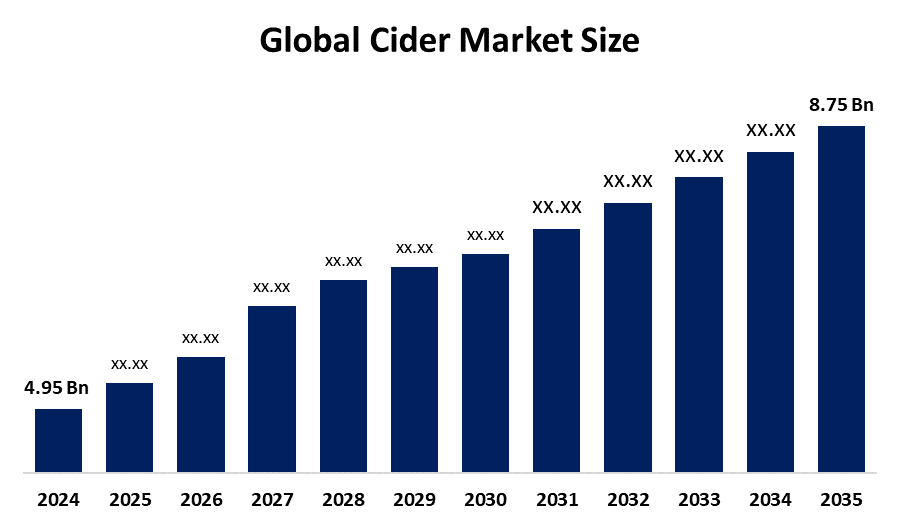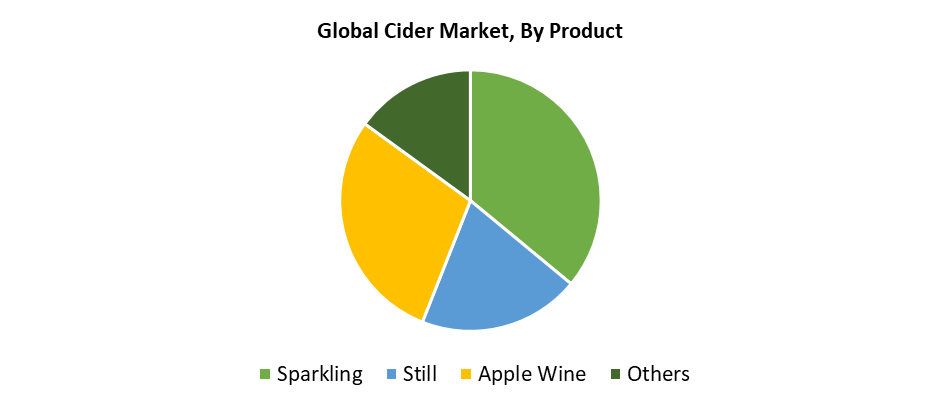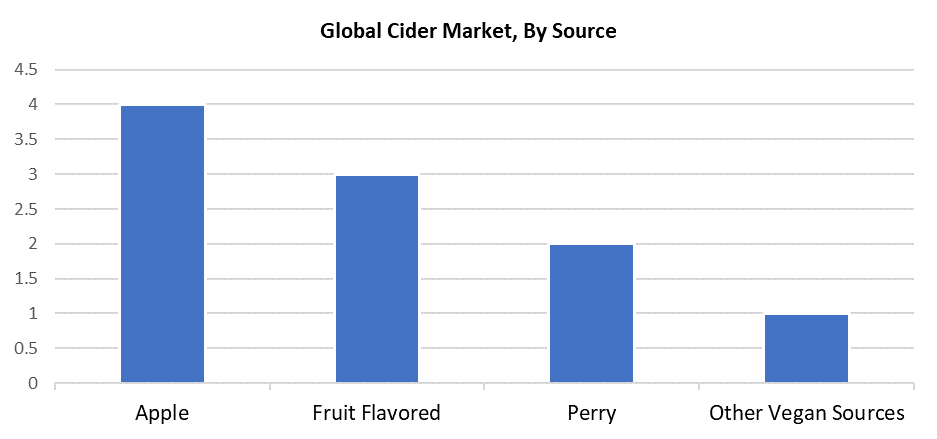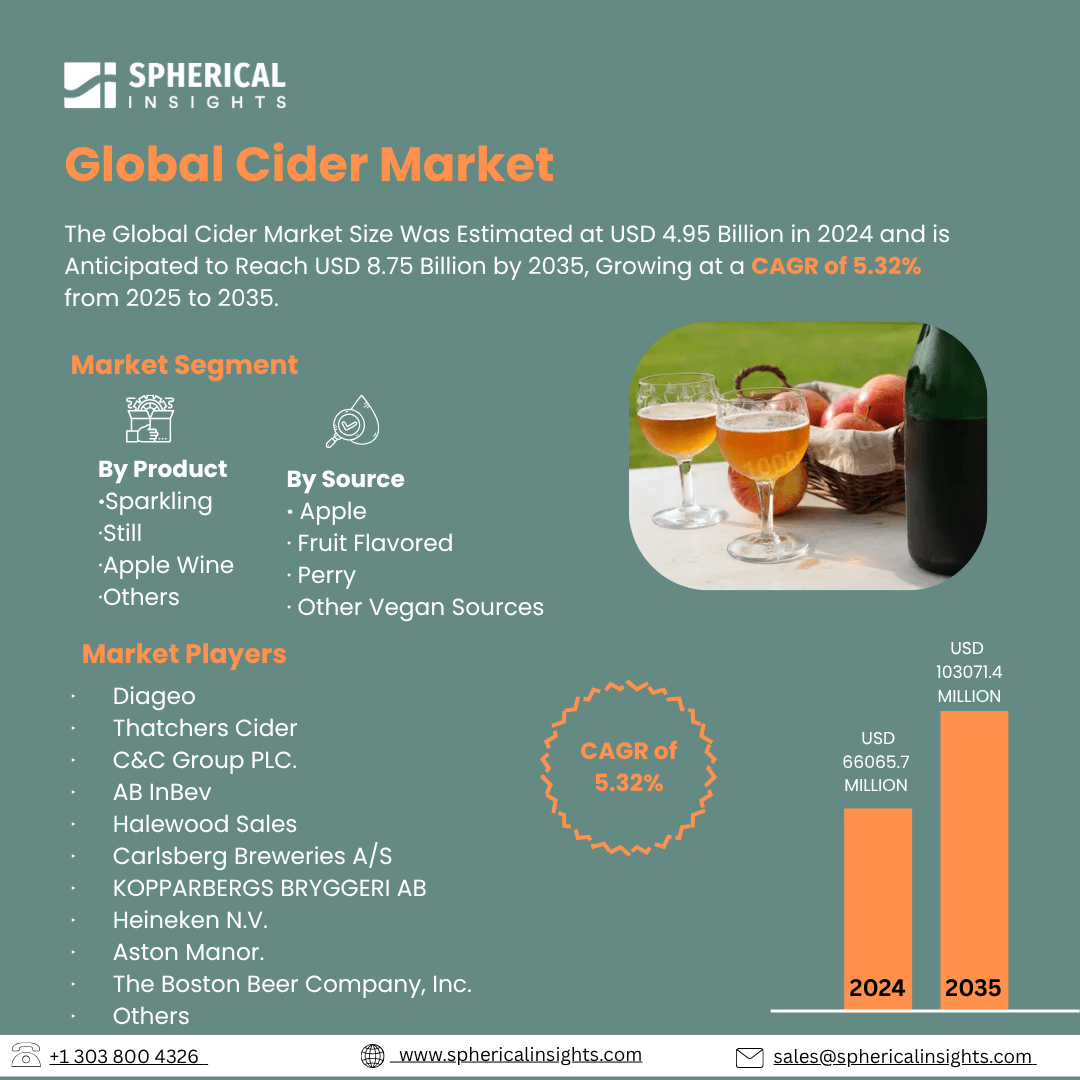Cider Market Summary
The Global Cider Market Size Was Estimated at USD 4.95 Billion in 2024 and is Anticipated to Reach USD 8.75 Billion by 2035, Growing at a CAGR of 5.32% from 2025 to 2035. A number of variables, such as shifting customer preferences for natural, craft, and healthier beverages, rising disposable incomes, and the emergence of e-commerce, are propelling the cider market's expansion. Additionally, cider's market is also growing as a result of flavor innovation and its increasing appeal as a flexible meal-matching choice.
Key Regional and Segment-Wise Insights
- In 2024, the European cider market dominated the global market and had the largest revenue share, at 36.6 %.
- Throughout the forecast period, the Asia Pacific cider market is anticipated to expand at the fastest CAGR of 4.7%.
- In 2024, the sparkling sector accounted for 36.4% of the cider market and held the biggest revenue share by product.
- According to the source, the apple segment dominated the cider industry by holding the biggest revenue share in 2024.
Global Market Forecast and Revenue Outlook
- 2024 Market Size: USD 4.95 Billion
- 2035 Projected Market Size: USD 8.75 Billion
- CAGR (2025-2035): 5.32%
- Europe: Largest market in 2024
- Asia Pacific: Fastest growing market

The cider market encompasses everything from manufacturing to marketing and distribution of this alcoholic beverage, which is made by fermenting apple juice. The market includes different types of cider products, such as still cider and sparkling cider, along with hard cider, which contains alcohol. The cider market shows substantial growth because customers are changing their preferences while distribution networks expand. The availability of cider in supermarkets, liquor stores, and online platforms enables an expanded customer base to purchase this beverage. Companies allocate funds to promotional activities that highlight how cider functions as a mixology and culinary ingredient. The health-conscious population turns to cider because it represents a gluten-free fruit-based alternative to beer and offers a lighter alcoholic beverage option. Well-known cider brand Angry Orchard has gained popularity through its diverse range of flavor profiles. The expansion of craft and artisanal cider manufacturers has increased market interest by offering customers innovative blends and boutique products that deliver premium drinking experiences.
International expansion functions as a major driving force behind the growing global cider market. Leading manufacturers pursue market development in regions such as Asia Pacific because alcoholic beverage consumption patterns evolve and disposable income rises among their consumers. The expanding middle class, combined with rising demand for premium alcoholic beverages, makes China and India interesting markets. Cider companies develop local flavors while establishing marketing strategies that align with regional cultures to benefit from market trends. Western lifestyle elements affect how consumers purchase products, but e-commerce growth in these nations enhances the availability of products to customers. The combined forces of these factors create a strong foundation for sustained growth in cider markets across the world.
Product Insights

Sparkling segment dominating the market by product with 36.4% of revenue share sales in 2024, because consumers choose it as a delicious and refreshing alternative to traditional alcoholic beverages. People select sparkling ciders for informal drinking and party events because of their light and bubbly characteristics. Companies such as Angry Orchard have successfully leveraged this trend by launching multiple fruit-flavored sparkling beverages that meet evolving customer tastes. Sparkling ciders contain antioxidants and potassium along with B vitamins riboflavin and niacin, which match the celebratory nature of non-alcoholic carbonated apple juice used in celebrations. The product does not serve diabetics well because it contains insufficient fiber content.
The apple wine market is expected to achieve the fastest CAGR during the forecast period because consumers want healthier and diverse alcoholic beverage choices. As wellness trends and clean-label preferences continue to rise, health-focused customers choose apple wine as a natural, low-alcohol alternative to traditional grape wines. People who want pure drinks with great flavor choose apple wine because it uses premium apples that typically have no pesticide residues. Apple wine's fruity taste, together with its moderate flavor profile, attracts multiple taste preferences, thus expanding its market reach. The premium beverage industry's shift toward organic ingredients and sustainable production methods makes apple wine more appealing to consumers.
Source Insights

The apple segment held the largest revenue share in the 2024 cider market because consumers prefer traditional apple-based flavors, which are well-known and adaptable for different tastes. The main component for cider production is apple fruit, which presents numerous flavor profiles that satisfy various taste preferences, including sweet and crisp as well as acidic and dry. Woodchuck Cidery and other companies have leveraged this trend by launching multiple apple cider products, including classic versions as well as spiced and fruit-infused options. The flexible nature of apple cider allows it to maintain its position as a market staple while attracting diverse age groups and event participants. The market continues to thrive because it offers simple access to consumers while preserving nostalgia and demonstrates flexibility to meet changing flavor preferences.
The fruit-flavored sector will experience the fastest growth during the projection period because consumers seek innovative beverage alternatives. Experimental and health-conscious consumers prefer these ciders, which offer natural ingredients with frequently reduced calorie contents. The beverage sector's shift toward premiumization and artisanal craftsmanship has driven rising interest in fruit-flavored ciders. Customers find appeal in blends that unite berries and citrus components together with tropical fruits and other ingredients. This market segment benefits from the ability to create restricted editions and seasonal products, which leads to better customer loyalty, together with increased engagement. The ever-expanding consumer base continues to show interest in fruit-flavored ciders as multiple producers explore new taste combinations.
Regional Insights
The North American cider market shows significant expansion because customers are choosing craft and artisanal beverages over traditional options. Cider makers now create multiple fruit-based combinations because Millennials and Gen Z customers want distinctive flavors and locally sourced products. Health-conscious consumers in the region choose cider because it serves as a gluten-free and lower-alcohol option compared to beer and spirits. The increase of cider-focused festivals and events has worked to boost consumer knowledge while developing dedicated cider communities. The combined elements drive the market expansion, which draws new consumers and sustains regular purchases throughout North America.
Europe Cider Market Trends
The Europe region led the worldwide cider industry in 2024 by holding a market share of 36.6% because of increasing consumer demand for craft and artisanal beverages. The health-conscious customer base in this region aligns perfectly with the rising demand for natural and locally sourced products, which drives this market expansion. The world's leading apple production area of Europe benefits from its plentiful raw material resources, which support cider production. The market has undergone substantial growth because of new flavor and style developments, which specifically target younger customer demographics. Kopparberg has successfully taken advantage of this trend through its offering of fruit-flavored ciders. The cider sector in the region is expanding strongly because of two rising markets within Poland and the Czech Republic.
Asia Pacific Cider Market Trends
The Asia Pacific cider market will experience the fastest growth at a CAGR of 4.7% during the forecast period because younger individuals are showing increasing interest in craft beverages. The demographic change proves most evident in China and India because local producers make ciders from lychee and Asian pear fruit to match regional preferences. Modern consumers select cider as their preferred beverage instead of beer because it provides a lighter and healthier choice among traditional alcoholic drinks. The rising use of fruit-based beverage additives has led to increased demand for fruit-flavored alcoholic beverages. Apple-flavored and exotic fruit ciders have become more popular, which positions Asia Pacific as a critical market for growth.
Key Cider Companies:
The following are the leading companies in the cider market. These companies collectively hold the largest market share and dictate industry trends.
- Diageo
- Thatchers Cider
- C&C Group PLC.
- AB InBev
- Halewood Sales
- Carlsberg Breweries A/S
- KOPPARBERGS BRYGGERI AB
- Heineken N.V.
- Aston Manor.
- The Boston Beer Company, Inc.
- Others
Recent Developments
- In May 2024, Budweiser Brewing Group launched Brutal Fruit Cider as its high-end cider to bring back the UK cider market. The fruit cider presents a cocktail-like light pink liquid which delivers citrus notes alongside ruby apple and subtle spice hints. The company partnered with British musician Pixie Lott for events and digital marketing to boost their product appeal and reach younger consumers.
- In March 2024, Heineken released Strongbow Zest cider to attract younger clientele and strengthen its position in the cider market. The fresh flavor combination of Strongbow Zest cider combines tart apple with citrus notes, which creates a lively drinking experience. Heineken delivers a low-calorie beverage option that maintains its taste quality to reach consumers who focus on their health.
Market Segment
This study forecasts revenue at global, regional, and country levels from 2020 to 2035. Spherical Insights has segmented the Cider Market based on the below-mentioned segments:
Global Cider Market, By Product
- Sparkling
- Still
- Apple Wine
- Others
Global Cider Market, By Source
- Apple
- Fruit Flavored
- Perry
- Other Vegan Sources
Global Cider Market, By Regional Analysis
- North America
- Europe
- Germany
- UK
- France
- Italy
- Spain
- Russia
- Rest of Europe
- Asia Pacific
- China
- Japan
- India
- South Korea
- Australia
- Rest of Asia Pacific
- South America
- Brazil
- Argentina
- Rest of South America
- Middle East & Africa
- UAE
- Saudi Arabia
- Qatar
- South Africa
- Rest of the Middle East & Africa






